A Bach cantata was playing when I arrived for a meeting at Lucien Le Moine in Beaune. From outside the premises look like a run down property in a street just outside the town center, but workmen were coming and going, and the interior had been handsomely renovated, practical rather than flashy, but with a certain contemporary flair.

Le Moine is the creation of Mounir and Rotem Saouma, who have been making wine here since 1998. It’s perhaps Burgundy’s top micro-negociant. The name reflects Mounir’s past experience working with monks. Mounir is a complicated person – “I listen to Dylan every day and read Nietzsche” – and conversation with him is thought-provoking, running in every direction like quicksilver. For every question I asked, the answer provoked more lines of investigation. He has a very definite view of winemaking. “I saw the need for a place where we would make wine in the old tradition – not the young tradition, which is the last 30-40 years. There was a window for a policy of ‘I don’t do.’ Many people were saying ‘I do so and so.’ The objective was to be as classic as possible.”
Before coming to Burgundy, Mounir was a winemaker in many places with many varieties, including Pinot Noir in hot climates. “It was hard to make good Pinot Noir so I came to the birthplace to see. I wanted people to see many examples of terroir and to see the difference.”
“Hundreds of years ago there was polyculture, there was a simple way of making wine: if it’s red, put it in a tank, push down the cap, press, wait, bottle. I tried experiments in 1997 in making wine very simply putting it in tank and leaving it. In 1998 we decided how to proceed. We are two people and we wanted to do 100 barrels of wine in premier and grand crus. We reached this size in 2006 and we are still at that size today. I have seen many negociants start small and become large. We do it all ourselves,” Mounir says, waving his hand to show a bandage where he hurt himself moving barrels yesterday.
There is just one village wine to show the potential of lower appellations. In the first year, there were 33 barrels representing 19 premier crus and 15 grand crus. In 2012, there were 112 barrels representing 75 premier and grand crus. 55% is red and 45% is white. “We could have done 10 barrels from each village, but we are making many more wines, in smaller amounts. Why do we have so many wines? Because I find the variety interesting.” 85% of the wines are the same every year. “Most of the growers from 1999 are still our growers today.”
The approach to winemaking is direct: let the wine have a slow and very long fermentation, and keep it on full lees for élevage. “We have very cold cellars so we never complete fermentation before ten months after harvest. Today (July 2014) we are at the end of the alcoholic fermentation and the malo is now starting for 2013.” Mounir emphasizes. “We put all the lees in the barrel, we use the heavy lees, I hate ‘fine lies,’ it means nothing.” There is no filtering or fining., and minimal use of sulfur. “I have a very curious friendship with sulfur…If I were the big boss of Burgundy, I would forbid the use of sulfur at two times: now in the spring, and at bottling. When you sulfur young wines very early, you keep them virgin and very shy. So when the wine finally sees oxygen it will be destroyed. Great Burgundy must be approachable when it is young. The problem with the sulfur is that it kills the wine. You can put makeup on, but it’s dead… We do not do wines without sulfur, but we age wines for 18 months without sulfur; this is a religion but it’s a risk thing. And then the sulfur is 15 ppm where Burgundy is usually 50 ppm. The key is that with slow alcoholic fermentation, late malo, and no racking, my wines are bottled with three times the average carbon dioxide for Burgundy.” The back label of every bottle carries a warning that the wine needs to be decanted before drinking in order to shake off the gas.
I don’t know whether aficionados of natural wine would apply the term “natural” to Mounir’s wines, but when I raise the question he says “I don’t like titles, natural means others are not, I do wine like people did in the old days, before the new tradition , I don’t know how you call it , we don’t add and don’t take out.” One of the charms of Lucien Le Moine as a producer is that it’s hard to peg by conventional descriptions. Take the question of new oak.”The policy in oak is not to talk about oak… I am happy you did not mention the presence (in the wines we tasted) of what I hate the most – oak flavor. New oak is expensive, it’s very complicated to use , but the moderate oxygen is very important for agibility of the wines. If a wine come from new oak without the (sense of) oak, it’s a sign of purity of terroir.”
“Unfortunately a lot of wines are more the man than the terroir, and they are boring. They do not change in the glass. And they are dead, they do not age. At the end of the day you open the bottle, you carafe it – any bottle we produce must be carafed – and it should last a week. The wine should change every day. It’s an obligation to respect the terroir and to keep the life in the wine. The definition of great wine in Burgundy for me rests on three points: the first is the place, the wine should smell and taste of the place; second is that it must have a life, it must change in the glass; third is that it must be able to age.
Do you control the vineyards? “We do the opposite of the others: I consider the best growers in the world are here, with a relationship between man and terroir. Who is going to stand in the vineyards and tell the growers what to do?” Basically, Mounir has confidence in his growers. “We try to find the person who makes the best interpretation in a cru. All arrangements with growers are on handshakes. We buy every year, we pay the price, we never say to a grower you must do something. In 2003 some growers said to me, you’ve made wine in hot countries, what do we do, but I wouldn’t intervene. I have no control, I learn from the growers, The growers have thirty vintages and then you have someone who arrives here and says, I’ll buy your grapes, and I’ll make wine. A lot of people ‘make’ Burgundy but you don’t have to ‘make’ Burgundy.”
For me, these wines are as natural as they need to be, with a wonderful purity of fruit allowing terroir to show itself at every level of the range. They are expensive and hard to find, but an eye opener as to the potential for minimal manipulation.
http://winespecific.com/
